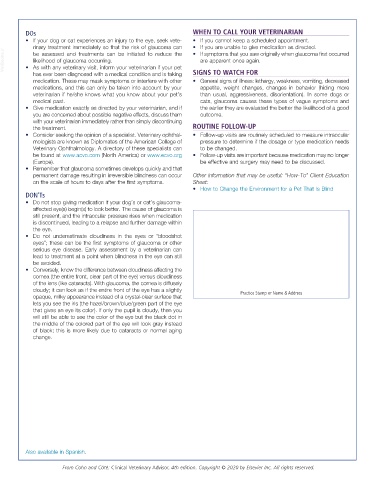Page 3016 - Cote clinical veterinary advisor dogs and cats 4th
P. 3016
DOs WHEN TO CALL YOUR VETERINARIAN
• If your dog or cat experiences an injury to the eye, seek vete- • If you cannot keep a scheduled appointment.
rinary treatment immediately so that the risk of glaucoma can • If you are unable to give medication as directed.
VetBooks.ir • As with any veterinary visit, inform your veterinarian if your pet are apparent once again.
• If symptoms that you saw originally when glaucoma first occurred
be assessed and treatments can be initiated to reduce the
likelihood of glaucoma occurring.
has ever been diagnosed with a medical condition and is taking SIGNS TO WATCH FOR
medication. These may mask symptoms or interfere with other • General signs of illness: lethargy, weakness, vomiting, decreased
medications, and this can only be taken into account by your appetite, weight changes, changes in behavior (hiding more
veterinarian if he/she knows what you know about your pet’s than usual, aggressiveness, disorientation). In some dogs or
medical past. cats, glaucoma causes these types of vague symptoms and
• Give medication exactly as directed by your veterinarian, and if the earlier they are evaluated the better the likelihood of a good
you are concerned about possible negative effects, discuss them outcome.
with your veterinarian immediately rather than simply discontinuing
the treatment. ROUTINE FOLLOW-UP
• Consider seeking the opinion of a specialist. Veterinary ophthal- • Follow-up visits are routinely scheduled to measure intraocular
mologists are known as Diplomates of the American College of pressure to determine if the dosage or type medication needs
Veterinary Ophthalmology. A directory of these specialists can to be changed.
be found at www.acvo.com (North America) or www.ecvo.org • Follow-up visits are important because medication may no longer
(Europe). be effective and surgery may need to be discussed.
• Remember that glaucoma sometimes develops quickly and that
permanent damage resulting in irreversible blindness can occur Other information that may be useful: “How-To” Client Education
on the scale of hours to days after the first symptoms. Sheet:
• How to Change the Environment for a Pet That Is Blind
DON’Ts
• Do not stop giving medication if your dog’s or cat’s glaucoma-
affected eye(s) begin(s) to look better. The cause of glaucoma is
still present, and the intraocular pressure rises when medication
is discontinued, leading to a relapse and further damage within
the eye.
• Do not underestimate cloudiness in the eyes or “bloodshot
eyes”; these can be the first symptoms of glaucoma or other
serious eye disease. Early assessment by a veterinarian can
lead to treatment at a point when blindness in the eye can still
be avoided.
• Conversely, know the difference between cloudiness affecting the
cornea (the entire front, clear part of the eye) versus cloudiness
of the lens (like cataracts). With glaucoma, the cornea is diffusely
cloudy; it can look as if the entire front of the eye has a slightly
opaque, milky appearance instead of a crystal-clear surface that Practice Stamp or Name & Address
lets you see the iris (the hazel/brown/blue/green part of the eye
that gives an eye its color). If only the pupil is cloudy, then you
will still be able to see the color of the eye but the black dot in
the middle of the colored part of the eye will look gray instead
of black; this is more likely due to cataracts or normal aging
change.
Also available in Spanish.
From Cohn and Côté: Clinical Veterinary Advisor, 4th edition. Copyright © 2020 by Elsevier Inc. All rights reserved.

